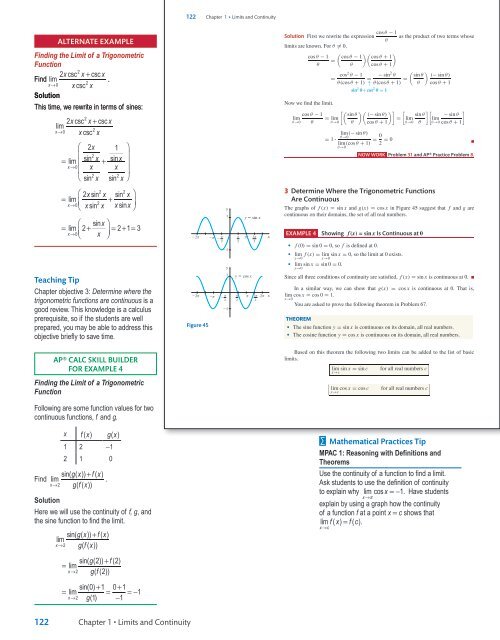Sullivan Microsite DigiSample
Create successful ePaper yourself
Turn your PDF publications into a flip-book with our unique Google optimized e-Paper software.
Teaching Tip<br />
Alternate Example<br />
Finding the Limit of a Trigonometric<br />
Function<br />
x x+<br />
x<br />
Find lim 2 csc 2<br />
csc .<br />
x→0<br />
2<br />
xcsc<br />
x<br />
Solution<br />
This time, we rewrite in terms of sines:<br />
x x+<br />
x<br />
lim 2 csc 2<br />
csc<br />
x→0<br />
2<br />
xcsc<br />
x<br />
⎛ 2x<br />
1 ⎞<br />
⎜ 2 ⎟<br />
= lim sin x<br />
⎜ + sin x<br />
⎟<br />
x→0<br />
⎜<br />
x x<br />
⎟<br />
⎝<br />
2 2<br />
sin x sin x ⎠<br />
⎛ x x x ⎞<br />
= lim ⎜<br />
2 sin 2 2<br />
sin<br />
+<br />
x→0<br />
2 ⎟<br />
⎝ xsin<br />
x xsin<br />
x⎠<br />
⎛ sin x ⎞<br />
= lim +<br />
⎝<br />
⎜ 2<br />
⎠<br />
⎟ = 2 + 1 = 3<br />
x→0<br />
x<br />
Chapter objective 3: Determine where the<br />
trigonometric functions are continuous is a<br />
good review. This knowledge is a calculus<br />
prerequisite, so if the students are well<br />
prepared, you may be able to address this<br />
objective briefly to save time.<br />
AP® CaLC skill builder<br />
for example 4<br />
Finding the Limit of a Trigonometric<br />
Function<br />
<strong>Sullivan</strong> AP˙<strong>Sullivan</strong>˙Chapter01 October 8, 2016 17:4<br />
122 Chapter 1 • Limits and Continuity<br />
2π π π π<br />
<br />
π<br />
2 2<br />
y<br />
1<br />
1<br />
y<br />
1<br />
1<br />
y cos x<br />
y sin x<br />
3π<br />
2<br />
2π π π π π 3π<br />
<br />
2π x<br />
2 2<br />
2<br />
Figure 45<br />
x<br />
<strong>Sullivan</strong><br />
Solution First we rewrite the expression cos θ − 1 as the product of two terms whose<br />
θ<br />
limits are known. For θ = 0,<br />
( )( )<br />
cos θ − 1 cos θ − 1 cos θ + 1<br />
=<br />
θ<br />
θ cos θ + 1<br />
= cos2 θ − 1<br />
θ(cos θ + 1) = − sin 2 ( )<br />
θ sin θ (− sin θ)<br />
↑ θ(cos θ + 1) = θ cos θ + 1<br />
sin 2 θ+ cos 2 θ = 1<br />
Now we find the limit.<br />
[( )( )] [ ][<br />
]<br />
cos θ − 1 sin θ (− sin θ)<br />
sin θ − sin θ<br />
lim = lim<br />
= lim lim<br />
θ→0 θ θ→0 θ cos θ + 1 θ→0 θ θ→0 cos θ + 1<br />
lim(− sin θ)<br />
θ→0<br />
= 1 ·<br />
lim (cos θ + 1) = 0 2 = 0<br />
■<br />
θ→0<br />
NOW WORK Problem 31 and AP® Practice Problem 8.<br />
3 Determine Where the Trigonometric Functions<br />
Are Continuous<br />
The graphs of f (x) = sin x and g(x) = cos x in Figure 45 suggest that f and g are<br />
continuous on their domains, the set of all real numbers.<br />
EXAMPLE 4 Showing f(x) = sin x Is Continuous at 0<br />
• f (0) = sin 0 = 0, so f is defined at 0.<br />
• lim f (x) = lim sin x = 0, so the limit at 0 exists.<br />
x→0 x→0<br />
• lim sin x = sin 0 = 0.<br />
x→0<br />
Since all three conditions of continuity are satisfied, f (x) = sin x is continuous at 0. ■<br />
In a similar way, we can show that g(x) = cos x is continuous at 0. That is,<br />
lim cos x = cos 0 = 1.<br />
x→0<br />
You are asked to prove the following theorem in Problem 67.<br />
THEOREM<br />
• The sine function y = sin x is continuous on its domain, all real numbers.<br />
• The cosine function y = cos x is continuous on its domain, all real numbers.<br />
Based on this theorem the following two limits can be added to the list of basic<br />
limits.<br />
lim sin x = sin c for all real numbers c<br />
x→c<br />
lim cos x = cos c for all real numbers c<br />
x→c<br />
Following are some function values for two<br />
continuous functions, f and g.<br />
x fx ( ) gx ( )<br />
1 2 −1<br />
2 1 0<br />
sin( gx ( )) + fx ( )<br />
Find lim .<br />
x→2<br />
gf (( x))<br />
Solution<br />
Here we will use the continuity of f, g, and<br />
the sine function to find the limit.<br />
sin( gx ( )) + fx ( )<br />
lim<br />
x→2<br />
gf (( x))<br />
∑ Mathematical Practices Tip<br />
MPAC 1: Reasoning with Definitions and<br />
Theorems<br />
Use the continuity of a function to find a limit.<br />
Ask students to use the definition of continuity<br />
to explain why lim cosx<br />
=−1.<br />
Have students<br />
x→π<br />
explain by using a graph how the continuity<br />
of a function f at a point x = c shows that<br />
lim f( x) = f( c).<br />
x→c<br />
sin( g(2)) + f(2)<br />
= lim<br />
x→2<br />
gf ((2))<br />
+ +<br />
= lim sin(0) 1 0 1 =<br />
− =− 1<br />
x→2<br />
g(1)<br />
1<br />
122<br />
Chapter 1 • Limits and Continuity<br />
TE_<strong>Sullivan</strong>_Chapter01_PART II.indd 5<br />
11/01/17 9:55 am




